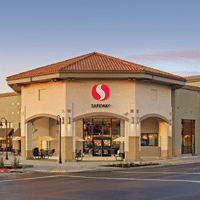Safeway, the fifth-largest grocery store chain in the United States, according to Supermarket News’ 2012 Top 75 Retailers and Wholesalers list, has made a substantial commitment to building and operating sustainable facilities. The grocer is on track to receive LEED certification for 10 stores this year and has ambitious plans for the years to come. Green building is one facet of Safeway’s complete sustainability strategy, which integrates environmental principles throughout every store, inside and out.
Safeway launched its sustainability strategy in 2004. In researching standards, the grocer determined that the LEED system was the best method for assessing progress and results, and with the help of consulting firm Architectural Energy Corporation, it designed a LEED-based program for its stores to follow. “We wanted to implement something that reflected what we were already doing rather than reinventing the wheel,” explains architect Jim Gibbon, an architectural coordinator for Safeway.
Safeway already had a long-standing practice of utilizing sustainable construction and design techniques; to participate in the LEED program, the company simply stepped up its game. As a result of the chain’s efforts, Safeway is ranked No. 8 on the EPA’s Green Power Partnership Program for Retailers, which lauds companies for their energy reduction and use of alternative energy sources.

The Safeway supermarket in Bethesda, MD, is the first LEED-certified grocery store in its county. Safeway uses eco-friendly building materials and practices in lighting and refrigeration to achieve the certification. Photos: Dan Cunningham
“From 2004 to about 2006, we developed a construction prototype which basically followed that standard,” Gibbon says. “At the time, we were developing our lifestyle décor for store interiors, and that gave us an opportunity to see how that fit with LEED points.” The company began referring to the LEED rating system when selecting materials and vendors.
Safeway’s first LEED-certified store was built in Santa Cruz, California. That store received LEED-NC Gold certification in 2010 with a total of 46 points. Among its key green features, the Santa Cruz store does not use any potable water for irrigation. What does it use? “The store produces about 1,000 gallons a day of defrost water, and that is what we’re using,” Gibbon says. He notes that this strategy is not ideal for every store; no two stores will utilize precisely the same array of efficiency strategies. Rather, Safeway’s goal is to utilize the greenest building techniques to build the most durable and user-friendly stores. “It’s about how much energy we use, how efficient we are in using it, how much water we use, the quality of the air, and the quality of the buildings’ mechanical systems,” Gibbon says. “They all affect the lifecycle cost of the building. Most of our stores have a 40- to 50-year lifecycle. If they are not designed [to last for decades], they are going to be a lot more expensive to operate and maintain.”
Safeway integrates credit-earning elements in ways that complement the aesthetics and overall feel of a store. The flooring in the floral and produce departments resembles hardwood, giving the area the look and feel of an indoor farmer’s market, but real hardwood floors are impractical for a building that receives endless foot traffic. Instead, Safeway chose durable vinyl flooring that looks like wood and is made from recycled materials. The vinyl can last up to 10 times longer than wood.

Safeway is a leader in green groceries. New stores have occupancy sensors, LED lighting, and planted and cool roofs to reduce heat island effect.
In addition to LEED certification, California Safeway stores are adapting construction practices to meet the state’s California Green Building Standard Code, or CALGreen, and the grocer also is looking to comply with the International Green Construction Code set by the International Code Council in Washington, DC. “Even though every building won’t be LEED certified, we are incorporating elements of the LEED standard in every building,” Gibbon says.
Nineteen of Safeway’s stores use solar power, and the company has two single-megawatt wind turbines supplying power to its Tracy, California, distribution center. New stores include elements such as cool roofs, which are systems designed to reduce heat island effect, occupancy sensors that dim lights in unoccupied areas of the store, LED lighting both inside and on exterior signs, and an energy-management system. Roof gardens are being tested in areas with high-moisture climates, and several stores in the Northwest also collect rainwater in retention ponds.
Since it began its sustainability strategy, Safeway has diverted 490,000 tons of materials from landfills, including construction waste, plastics, cardboard, cooking oil, and compostables.

